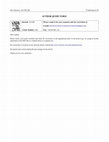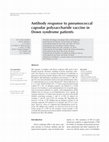Papers by Ricardo Sorensen

Tubercle and lung disease : the official journal of the International Union against Tuberculosis and Lung Disease, 1995
Tuberculin testing is an accepted method for screening pregnant women for tuberculosis. The inter... more Tuberculin testing is an accepted method for screening pregnant women for tuberculosis. The interpretation of tuberculin reactivity in bacillus Calmette-Guerin (BCG)-immunized pregnant women is still in debate. Four related issues were addressed: (1) The effect of pregnancy on tuberculin reactivity; (2) the effect of age differential on tuberculin reactivity; (3) the effect of repeated immunization with BCG; and (4) the risk of developing tuberculosis during pregnancy or a 3-year post-partum period. We performed tuberculin testing in 840 healthy Chilean women in the 32nd to 34th week of pregnancy; 807 had been immunized with 1 or more doses of BCG. There were 3 age groups: 177 were < or = 19 years old, 534 were 20-29 years old, and 129 were > or = 30 years old. All women in the study were followed at least 3 years post-partum. Women < or = 19 years old and non-pregnant women of similar age studied in the same geographical area had a similar distribution of the size of tuber...
Revista alergia Mexico (Tecamachalco, Puebla, Mexico : 1993)
ENETICALLY DETERMINED deficiency of the G enzyme adenosine deaminase (ADA) is a cause of the clin... more ENETICALLY DETERMINED deficiency of the G enzyme adenosine deaminase (ADA) is a cause of the clinical syndrome of severe combined immunodefi- ciency (SCID) with its associated recurrent infections and failure to thrive. If untreated, the condition is usually fatal
Sao Paulo Medical Journal, 1998
Metabolic and hematologic changes occurring after rapid intravenous infusion of gammaglobulin in ... more Metabolic and hematologic changes occurring after rapid intravenous infusion of gammaglobulin in patients with antibody deficiency syndromes.
Pediatric Research, 1993
During the past 6 y, 29 adenosine deaminase (ADA)-deficient patients with combined immunodeficien... more During the past 6 y, 29 adenosine deaminase (ADA)-deficient patients with combined immunodeficiency have been treated with polyethylene glycol (PEG)-modified bovine ADA (PEG-ADA). We have monitored plasma ADA activity, metabolic effects of treatment, and the evolution of antibody to PEG-ADA in these patients, in collaboration with immunologists and clinicians in North America, Europe, and Australia, who have monitored immune function and clinical response to treatment. This article summarizes the current status of PEG-ADA therapy and provides recommendations for its use. Recovery of specific immune function during treatment with PEG-ADA is illustrated for three patients, who represent early, delayed, these patients have entered a trial of gene therapy, but continue to receive enzyme replacement.
Pediatric Pulmonology, 1996

The Pediatric Infectious Disease Journal, 1998
To determine whether children with recurrent respiratory infections who failed to respond to the ... more To determine whether children with recurrent respiratory infections who failed to respond to the conventional polysaccharide vaccine would respond to a pneumococcal conjugate vaccine. Children referred to our clinic for recurrent respiratory infections who had no known primary or secondary immunodeficiencies were immunized with a 23-valent pneumococcal polysaccharide vaccine. IgG antibodies to pneumococcal serotypes 1, 3, 4, 6B, 9V, 14, 18C, 19F and 23F were determined by enzyme-linked immunosorbent assay before and 4 to 6 weeks after immunization. An adequate IgG antibody response to an individual serotype was arbitrarily defined as a postimmunization antibody titer &amp;amp;amp;amp;amp;amp;amp;amp;amp;amp;amp;amp;amp;amp;amp;amp;amp;amp;amp;amp;amp;amp;amp;amp;amp;amp;amp;amp;amp;amp;amp;amp;amp;amp;amp;amp;amp;amp;amp;amp;amp;amp;amp;amp;amp;amp;amp;amp;amp;amp;amp;amp;gt; or =1.3 microg/ml or at least 4 times the preimmunization value. Immunization with an experimental CRM197-heptavalent pneumococcal conjugate vaccine was offered to patients without an adequate response to 4 or more vaccine serotypes (nonresponders). Post-conjugate immunization antibody concentrations were measured 4 to 6 weeks later. In nonresponder patients (n = 17) geometric mean post-conjugate immunization (C) serum antibody concentrations (microg/ml) compared with post-polysaccharide (PS) concentrations were: (serotype, C vs. PS) 4, 1.11 vs. 0.30 (P = 0.000227); 6B, 0.46 vs. 0.20 (P = 0.017267); 9V, 0.82 vs. 0.29 (P = 0.002163); 14, 1.88 vs. 0.27 (P = 0.000615); 18C, 0.98 vs. 0.32 (P = 0.021962); 19F, 1.24 vs. 0.34 (P = 0.002844); and 23F, 0.87 vs. 0.16 (P = 0.000194). In responder patients (n = 67), after 1 dose of the polysaccharide vaccine, geometric mean antibody concentrations were: 4, 1.05; 6B, 0.96; 9V, 1.55; 14, 1.65; 18C, 1.62; 19F, 1.30; and 23F, 1.02. Our results show that a pneumococcal conjugate vaccine is capable of inducing an IgG response in patients with recurrent infections who had failed to mount an adequate response to the polysaccharide vaccine. Conjugate vaccines may be of value in the management of children with recurrent pneumococcal respiratory infections.

Pediatric Clinics of North America, 2000
Antibodies have a crucial role in protecting against infections, and antibody deficiencies are th... more Antibodies have a crucial role in protecting against infections, and antibody deficiencies are the commonest primary and secondary immunodeficiencies. Antibody deficiencies may be the only abnormality present in a patient, or they may be present and aggravate the symptoms of various other conditions. Because the presence of an antibody deficiency is difficult to predict from clinical presentation, physicians should perform an evaluation of antibody-mediated immunity, even knowing that, in many cases, the results are normal. When immunizations are included as a part of the evaluation, many patients experience a benefit from enhanced immunity against common pathogens. Some alternative practical approaches to the evaluation of patients with recurrent infections are outlined in Figure 8. Referral to a clinical immunologist can be based on the presence of recurrent infections, a positive family history without prior evaluation by a pediatrician, or abnormal immunologic findings that require an advanced evaluation. In any case, a close collaboration between pediatrician and immunologist likely will result in an accurate diagnosis and better treatment of patients with antibody-deficiency syndromes and their families.

Pediatric Allergy and Immunology, 2005
The objective of this study was to evaluate humoral immunity of allergic respiratory children wit... more The objective of this study was to evaluate humoral immunity of allergic respiratory children with chronic/recurrent sinusitis. Twenty-seven allergic respiratory (persistent mild/moderate asthma and persistent allergic rhinitis) children (7-15-year old) with chronic or recurrent sinusitis were evaluated. Patients had symptoms and abnormal computer tomography scan even after two adequate treatments (long-lasting antibiotics, decongestants, and short-term oral corticosteroids). clinical examination, sweat test, total blood cell count, measurement of serum levels of: total and specific IgE, immunoglobulins (G, M, A), IgG subclasses, antibodies to Haemophilus influenza type b (IgG anti-Ps Hib) and pneumococcal serotypes (IgG anti-Ps 1, 3, 5, 6B, 9V, and 14) before and after active immunization (Act-Hib and Pneumo23, Aventis Pasteur SA, Lyon, France), Rubella neutralizing antibody titers and human immunodeficiency virus antibodies. Specific IgE to inhalant allergens higher than class III were observed in 24/27 patients. One patient had IgA plus IgG2 deficiency and other an IgG3 deficiency. Eight and 12 of 27 patients had IgG2 and IgG3 serum levels below 2.5th percentile, respectively. Immunological responses to protein and polysaccharide antigens were normal in all patients. Although our patients have been appropriately treated of their allergic diseases, they persisted with chronic/recurrent sinusitis and 60% of them had a documented osteomeatal complex blockade. In spite of the diagnosis of IgA plus IgG2 deficiency and an isolated IgG3 deficiency, in all patients an adequate response to Ps antigens was observed. Primary and/or secondary humoral immunodeficiency seems not to be the main cause of chronic/recurrent sinusitis in patients with respiratory allergic disease.
Nutrition Research, 1998
... 1420 MC PORCH et al. ... Hospital, Medical Center of Louisiana, and West Jefferson Medical Ce... more ... 1420 MC PORCH et al. ... Hospital, Medical Center of Louisiana, and West Jefferson Medical Center, and especially Marc A. Fisher, MD and the following participating pediatricians for their support in the performance of this study: Harish C. Anand, MD, Grace Banuchi, MD, Louis ...
New England Journal of Medicine, 2002
Conclusions Ex vivo gene therapy with g c can safely correct the immune deficiency of patients wi... more Conclusions Ex vivo gene therapy with g c can safely correct the immune deficiency of patients with X-linked severe combined immunodeficiency. (N Engl
New England Journal of Medicine, 2010
BACKGROUND-The outcomes of gene therapy to correct congenital immunodeficiencies are unknown. We ... more BACKGROUND-The outcomes of gene therapy to correct congenital immunodeficiencies are unknown. We reviewed long-term outcomes after gene therapy in nine patients with X-linked severe combined immunodeficiency (SCID-X1), which is characterized by the absence of the cytokine receptor common γ chain.

Journal of Clinical Investigation, 1993
We examined the genetic basis for adenosine deaminase (ADA) deficiency in seven patients with lat... more We examined the genetic basis for adenosine deaminase (ADA) deficiency in seven patients with late/delayed onset of immunodeficiency, an underdiagnosed and relatively unstudied condition. Deoxyadenosine-mediated metabolic abnormalities were less severe than in the usual, early-onset disorder. Six patients were compound heterozygotes; 7 of 10 mutations found were novel, including one deletion (delta 1019-1020), three missense (Arg156 &amp;amp;amp;amp;amp;amp;gt; His, Arg101 &amp;amp;amp;amp;amp;amp;gt; Leu, Val177 &amp;amp;amp;amp;amp;amp;gt; Met), and three splicing defects (IVS 5, 5&amp;amp;amp;amp;amp;amp;#39;ss T+6 &amp;amp;amp;amp;amp;amp;gt; A; IVS 10, 5&amp;amp;amp;amp;amp;amp;#39;ss G+1 &amp;amp;amp;amp;amp;amp;gt; A; IVS 10, 3&amp;amp;amp;amp;amp;amp;#39;ss G-34 &amp;amp;amp;amp;amp;amp;gt; A). Four of the mutations generated stop signals at codons 131, 321, 334, and 348; transcripts of all but the last, due to delta 1019-1020, were severely reduced. delta 1019-1020 (like delta 955-959, found in one patient and apparently recurrent) is at a short deletional hot spot. Arg156 &amp;amp;amp;amp;amp;amp;gt; His, the product of which had detectable activity, was found in three patients whose second alleles were unlikely to yield active ADA. The oldest patient diagnosed was homozygous for a single base change in intron 10, which activates a cryptic splice acceptor, resulting in a protein with 100 extra amino acids. We speculate that this &amp;amp;amp;amp;amp;amp;quot;macro ADA,&amp;amp;amp;amp;amp;amp;quot; as well as the Arg156 &amp;amp;amp;amp;amp;amp;gt; His, Arg101 &amp;amp;amp;amp;amp;amp;gt; Leu, Ser291 &amp;amp;amp;amp;amp;amp;gt; Leu, and delta 1019-1020 products, may contribute to mild phenotype. Tissue-specific variation in splicing efficiency may also ameliorate disease severity in patients with splicing mutations.

Journal of Clinical Investigation, 2008
Previously, several individuals with X-linked SCID (SCID-X1) were treated by gene therapy to rest... more Previously, several individuals with X-linked SCID (SCID-X1) were treated by gene therapy to restore the missing IL-2 receptor gamma (IL2RG) gene to CD34+ BM precursor cells using gammaretroviral vectors. While 9 of 10 patients were successfully treated, 4 of the 9 developed T cell leukemia 31-68 months after gene therapy. In 2 of these cases, blast cells contained activating vector insertions near the LIM domain-only 2 (LMO2) proto-oncogene. Here, we report data on the 2 most recent adverse events, which occurred in patients 7 and 10. In patient 10, blast cells contained an integrated vector near LMO2 and a second integrated vector near the proto-oncogene BMI1. In patient 7, blast cells contained an integrated vector near a third proto-oncogene,CCND2. Additional genetic abnormalities in the patients&amp;amp;amp;amp;amp;amp;amp;amp;amp;amp;amp;amp;amp;amp;amp;amp;amp;amp;amp;amp;amp;amp;amp;amp;amp;amp;amp;amp;amp;amp;amp;amp;amp;amp;amp;amp;amp;amp;amp;amp;amp;amp;amp;amp;amp;amp;amp;amp;amp;amp;amp;amp;amp;amp;amp;amp;amp;amp;amp;amp;amp;amp;#39; blast cells included chromosomal translocations, gain-of-function mutations activating NOTCH1, and copy number changes, including deletion of tumor suppressor gene CDKN2A, 6q interstitial losses, and SIL-TAL1 rearrangement. These findings functionally specify a genetic network that controls growth in T cell progenitors. Chemotherapy led to sustained remission in 3 of the 4 cases of T cell leukemia, but failed in the fourth. Successful chemotherapy was associated with restoration of polyclonal transduced T cell populations. As a result, the treated patients continued to benefit from therapeutic gene transfer.
Journal of Allergy and Clinical Immunology, 2000
Journal of Allergy and Clinical Immunology, 2006
Journal of Allergy and Clinical Immunology, 2008
The identification of the molecular bases of more than 130 primary immunodeficiency diseases has ... more The identification of the molecular bases of more than 130 primary immunodeficiency diseases has prompted the use of mutation analysis in the diagnostic approach to these patients. Here we discuss the importance of and the limitations associated with molecular diagnosis of these disorders and emphasize the need that mutation analysis be accompanied by appropriate evidence that the identified genetic defect has pathologic consequences on RNA/protein expression and function.

Allergologia et Immunopathologia, 2011
Experts from six Latin American countries met to discuss critical issues and needs in the diagnos... more Experts from six Latin American countries met to discuss critical issues and needs in the diagnosis and management of primary immunodeficiency diseases (PIDD). The diagnosis of PIDD is generally made following referral to an immunology centre located in a major city, but many paediatricians and general practitioners are not sufficiently trained to suspect PIDD in the first place. Access to laboratory testing is generally limited, and only some screening tests are typically covered by government health programmes. Specialised diagnostic tests are generally not reimbursed. Access to treatment varies by country reflecting differences in healthcare systems and reimbursement policies. An online PIDD Registry Programme for Latin America has been available since 2009, which will provide information about PIDD epidemiology in the region. Additional collaboration across countries appears feasible in at least two areas: a laboratory network to facilitate the diagnosis of PIDD, and educational programmes to improve PIDD awareness. In total, these collaborations should make it possible to advance the diagnosis and management of PIDD in Latin America.

Brazilian Journal of Medical and Biological Research, 2006
The majority of children with Down syndrome (DS) tend to have frequent bacterial infections inclu... more The majority of children with Down syndrome (DS) tend to have frequent bacterial infections including recurrent respiratory infections. Our objective was to evaluate the production of antibodies to pneumococcal polysaccharide antigens after active immunization in DS subjects. IgG antibodies to pneumococcal serotypes (1, 3, 6B, 9V, and 14) were measured before and 6 weeks after immunization with a 23-valent pneumococcal vaccine (Pneumo23 ® , Pasteur-Merrieux) in 6-to 13-year-old DS children (N = 17) and in aged-matched normal controls (N = 30). An adequate response was defined as a 4-fold increase over baseline or a post-immunization level of specific pneumococcal serotype antibody ≥1.3 µg/mL. After immunization, all DS children had an increase in post-immunization levels against all serotypes analyzed. A 4-fold or more increase was observed in all DS children concerning serotypes 1 and 14, in 90% of subjects for serotypes 3 and 9V, and in 65% for serotype 6B. Regarding this increase, 8 of the 17 DS children had an adequate response to all serotypes analyzed, 8/17 patients to 4 serotypes and 1/17 to 3 serotypes. However, when we compared post-immunization levels between DS children and controls, we observed lower levels in the former group (P < 0.05) for all serotypes except serotype 3. We conclude that pneumococcal polysaccharide immunization could be beneficial for these DS children. Correspondence B.T.









Uploads
Papers by Ricardo Sorensen